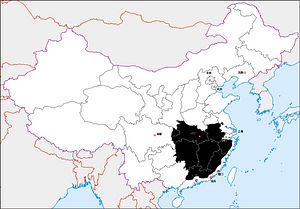This article series explores 12 distinct “regions” within China: six “core” regions long dominated by the majority Han ethnic group and six “periphery” regions home to many of China’s ethnic minorities. The series overview is available here. To view the full series, click here.
From Chongqing, the Yangtze River descends through its famed gorges onto an alluvial plain, south of which is a terrain of forested mountains and valleys stretching to the southeast coast. This is the central-south region. The Yangtze floods seasonally into China’s biggest freshwater lakes, Dongting and Poyang, which are rich fishing grounds and migratory bird sanctuaries. The mountains of the region’s northwest are associated with Taoist practice and “internal” martial arts – contrasted to the “external arts” linked with northern China’s Shaolin monastery – and scenery that inspired the floating mountains of James Cameron’s Avatar.
The Yangtze plain was the original frontier for Han Chinese expansion southward from the North China plain at the expense of aboriginal peoples, a millennia-long and often violent process that has been compared to Europe’s drang nach osten. In imperial times the military importance of the Yangtze River made this a strategic “pivot region,” witness to numerous and much-cinematized battles, including what may have been the biggest pre-industrial naval clash in history. During the 13th century the Mongols conquered China by breaking defenses on the middle Yangtze, and in the 14th the new Ming regime secured its dominance by riverine campaigns in the opposite direction.
Beyond the Yangtze plain, the river valleys winding between central-south China’s mountains – forested country so wild that tigers still roamed here in the 1980s – provide routes to the southeast coast, which have been used by armies from those of China’s first emperor to the 19th century Taipings and 20th century Nationalists.
Men from Hunan acquired a reputation for militancy, xenophobia, and sharp-tongued directness, qualities that some would say were epitomized in the province’s most famous son, Mao Zedong. Hunan certainly produced an outsized share of military and revolutionary leaders during China’s tumultuous century from the mid-1800s. The mountainous uplands of neighboring Jiangxi province were the original stronghold of the Chinese Communists in the 1930s, from which they set out on the Long March to escape destruction by Chiang Kai-shek’s Nationalist forces. Still further east, the mountains of Guangdong and Fujian are home to the Han sub-group called the Hakka (客家), whose communal roundhouses were once mistakenly identified in U.S. satellite imagery as ballistic missile silos.
Dominating the middle Yangtze plain is the metropolis of Wuhan, location of the uprising that catalyzed China’s 1911 revolution, and a transport hub called the “thoroughfare of nine provinces” (九省通渠). Today, Wuhan’s diversified economy includes one of China’s three submarine construction yards. Upstream on the Yangtze, the Three Gorges Dam is the world’s biggest hydroelectric station by capacity, built at the cost of displacing 1.3 million people, submerging cultural sites, and triggering ecological changes yet to be quantified. Hunan’s capital Changsha is home to the world’s tallest planned skyscraper (construction on which is currently suspended) and to Sany, among the world’s largest heavy machinery makers and one of the “frontrunner firms” in China’s race to the global technological frontier.
Next up: The Yangtze delta.
John Lee is a former visiting fellow of the Mercator Institute for China Studies. He tweets at @J_B_C16.

































